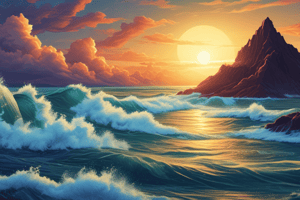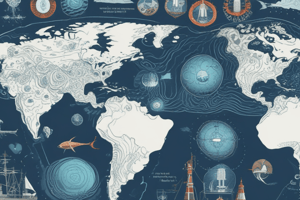Podcast
Questions and Answers
What percentage of the Earth's surface is covered by water?
What percentage of the Earth's surface is covered by water?
- 80%
- 70% (correct)
- 60%
- 90%
What is the composition of water?
What is the composition of water?
- O2H
- H2O2
- HO2
- H2O (correct)
What is the unique feature of the underwater cave system in the Bahamas?
What is the unique feature of the underwater cave system in the Bahamas?
- The presence of stalactites and fossils (correct)
- The presence of coral reefs
- The presence of treasure
- The presence of sharks
What is the purpose of the halocline in the blue holes?
What is the purpose of the halocline in the blue holes?
What is unique about the remipedes found in the dark, saltwater caves?
What is unique about the remipedes found in the dark, saltwater caves?
What is the location of the mid-ocean ridge?
What is the location of the mid-ocean ridge?
What is believed to have brought water to Earth?
What is believed to have brought water to Earth?
What is the purpose of the OSIRIS-REx spacecraft?
What is the purpose of the OSIRIS-REx spacecraft?
Why is water essential for life on Earth?
Why is water essential for life on Earth?
What is being studied in the Baltic Sea?
What is being studied in the Baltic Sea?
What is unique about water as a liquid?
What is unique about water as a liquid?
What is being explored in South Africa?
What is being explored in South Africa?
Flashcards are hidden until you start studying
Study Notes
• Water covers 70% of the Earth's surface, making it a unique planet, and is essential for life. • Water exists in three states: liquid, solid, and gaseous, and is composed of hydrogen and oxygen atoms (H2O). • The Bahamas, an island paradise in the Atlantic, is home to numerous coral reefs and a vast underwater cave system. • The cave system, formed during the Ice Age, features stalactites and fossils thousands of years old, preserved in clear water with low oxygen levels. • The Bahamas' unique underwater world is characterized by blue holes, which are formed when the sea level rises and floods the caves. • Freshwater and seawater coexist in the blue holes, with freshwater floating on top of the heavier seawater. • The halocline, a thin divide, separates the two aquatic worlds, and fish are unable to swim through it due to differences in salt concentration. • Remipedes, crustaceans that resemble centipedes, are found in the dark, saltwater caves, and have lost their eyes over time. • These ancient creatures, which predate dinosaurs, are helping scientists understand the Earth's development and the formation of the Atlantic Ocean. • Iceland, located on a fissure between two continental plates, provides a unique opportunity to dive between the continents and explore the Earth's crust. • The mid-ocean ridge, the longest mountain range on Earth, is formed by eruptions and the movement of tectonic plates. • Hydrothermal vents, like the one in Iceland, are thought to have given rise to life on Earth, providing ideal conditions for the building blocks of life to come together. • Astronomers believe that water was brought to Earth by meteorites, which are composed of water, clays, and hydrated minerals. • The early days of our solar system were marked by a bombardment of meteorites, which may have transported water and the building blocks of life to Earth.Here is a summary of the text in detailed bullet points:
• NASA launched the OSIRIS-REx spacecraft in September 2016 to collect samples from the asteroid Bennu, which is 500 meters in diameter and orbits close to Earth.
• The asteroid is a fossil from the early solar system, 4.5 billion years old, and could provide insight into how water came to Earth from outer space.
• The spacecraft will return to Earth in 2023 with samples that could contain water and building blocks of life.
• Water is essential for life, but it's not found on other planets like Mercury, which is too close to the sun, and Mars, where water evaporated over time.
• On Earth, water is crucial for marine life, with over 10 million species living in the oceans, and sound plays a vital role in underwater communication.
• Whale researcher Nan Hauser has been studying humpback whales in the Cook Islands for 30 years, recording their songs and behavior.
• Free divers can observe whales up close without scuba gear, allowing for unique observations, and skin samples can provide information on whale migration patterns.
• The ocean's currents distribute warmth, food, and energy, controlling life in the seas, and researchers are studying the Gulf Stream and other ocean currents to understand their impact on climate.
• The Baltic Sea is being studied to understand the role of small eddies in ocean currents, using aircraft, airships, and research vessels to track these short-lived whirlpools.
• Clouds are crucial for precipitation, and researchers are studying cloud formation and rain production to improve weather forecasting.
• Cloud researcher Everhard Bordach wants to understand how rain forms and how to predict it, using advanced technology to study cloud droplets and collisions.
• Water is essential for life on Earth, and its unique properties, such as maximum density as a liquid, allow life to exist under ice and in extreme conditions.
• Lake Baikal in Russia is home to a species of seal that survives under the ice, and researchers are studying the characteristics of water in the lake.
• In South Africa, researchers are exploring the deepest mine in the world to find ancient water and microorganisms that can survive in extreme conditions.
• The mine, Mponeng, is over 3 kilometers underground, and the team is drilling into the fault zone to find water and study its properties.
• The researchers find remarkable worms, around half a millimeter in size, living in the extreme conditions, and discover that life can exist in the most inhospitable places.
• The team is studying the water cycle, from the poles to the equator, and how it affects the climate, glaciers, and sea levels.
• In the Arctic, researchers are studying the glacier's movement and meltwater flow to understand the impact of global warming on the region.
• The glacier's ice crystals are unique, and the team installs sensors to measure pressure, temperature, and movement, which will help scientists understand the glacier's dynamics.
• The glacier's movement is affected by the amount of water at its base, which lubricates the interface between the ice and rock, allowing it to slide faster.
• The team's findings will provide crucial data on the glacier's melting rate and its impact on sea levels and the ecosystem.
Studying That Suits You
Use AI to generate personalized quizzes and flashcards to suit your learning preferences.




